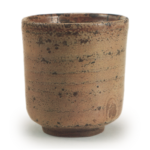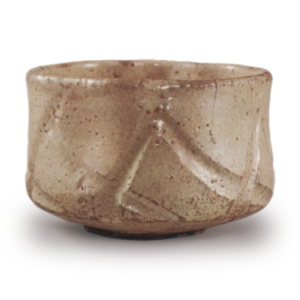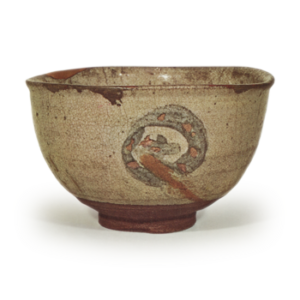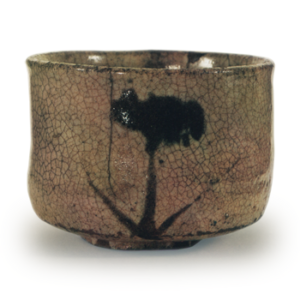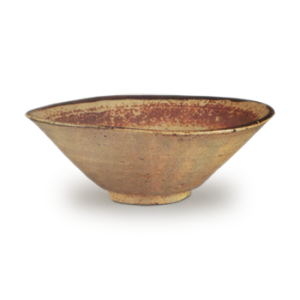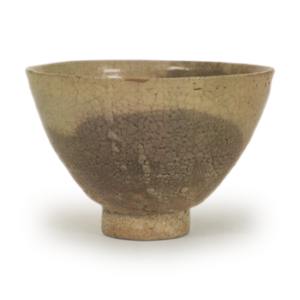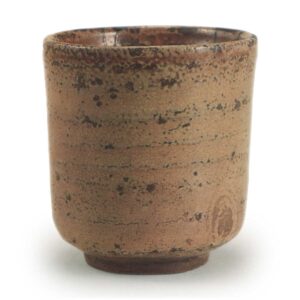
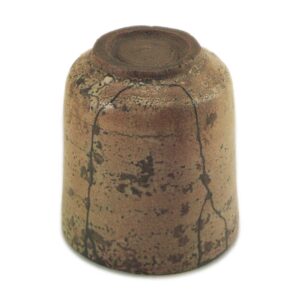
Height: 10.5cm
Diameter: 9.2-9.6cm
Height of foot ring: 5.4cm
Height of same: 0.5cm
The term “nenoko mochi” (literally “piglet rice cakes”) appears only once in The Tale of Genji, and refers to a special kind of rice cake. Inoko mochi is a rice cake eaten on the first day of the tenth month of the lunar calendar to celebrate good health and longevity, or the prosperity of one’s descendants. In the Aoi chapter of the Tale of Genji, there is a touching scene where Genji offers Inoko mochi to Ishizu, and as this happened on the day after the first day of the tenth month, it was called “Inoko” in a playful way.
The name “Nenoko-mochi” was given to this teacup by Hosokawa Sansai, who was well-versed in the Tale of Genji, and the origin of the name is said to be that there were three famous tea bowls in the possession of Rikyu: a kyogen hakama, a hiki-ki scabbard, and this Karatsu teacup, and it is thought that the name was given in reference to the number of neko-mochi in the story, which says “even if three are one”. It may also be that this is a reference to the phrase “the shape of the rice cakes is also particularly beautiful and looks very attractive” and the fact that the exterior of this cylindrical tea bowl has a neat, orderly appearance, like a stack of rice cakes.
This tea bowl is a large, plain, deep cylindrical bowl, which is rare among the Karatsu tea bowls that have survived to the present day. It has a simple, straightforward shape, and is indeed an old-fashioned tea bowl that gives the impression of a relaxed, open-hearted character, and it is a form that cannot be overlooked as a tea bowl that would have been favored by Rikyu.
The clay is coarse clay containing iron, which is characteristic of Karatsu. The back of the foot shows the rough, dry texture of the clay, which contains iron. The foot, which has been roughly carved out, is somewhat thin in places, and the work is overflowing with a rustic charm. The waist is gently rounded, and the rise from the body to the rim is straight and drawn up with a free-flowing potter’s wheel. There is a slight widening around the rim, which makes the bowl look larger. And under the glaze, you can see the regular, light-colored lines of the potter’s wheel running through it. The exterior is a simple, smooth shape, but the framework is thick and robust, and it is impossible not to think that it is extraordinary.
The glaze is a translucent white with a hint of blue, and it is applied right up to the foot ring. Perhaps due to the iron content of the clay, the glaze has a slight reddish tinge, and in some places it is a so-called loquat color, while in places where the glaze layer is thin, it is somewhat darker. In addition, fine cracks can be seen all over the surface, giving the glaze a similar appearance to that of Oku-Koryo ware. The glaze surface is not necessarily smooth.
There are large finger marks from when the glaze was applied, and on the marks of the potter’s wheel, there are countless small holes lined up horizontally, forming multiple layers. In addition, there are small spots of glaze flaking off here and there, scattered like pockmarks.
The fact that it was owned by Rikyu is a rare example in Karatsu. Hosokawa Sansai wrote an inscription on the box, so it is likely that it came into his possession at that time. It was later owned by Takagi Gensai, and then by Kanjian Munenobu (Sakamoto Shusai), and in 1771 it was passed on from Imai Gennojo to Suwa Nobutada. It then passed into the possession of the Konoike family, and is now owned by a certain family in the Kansai region. The inscription on the front of the inner box lid, “Kono no mochi” (rice cakes for children), is by Hosokawa Sansai. The inscription on the front of the middle box lid, “Neko no ko” (children of the cat), is by Funakoshi Iyomori, and the paper on the back of the same box lid is by Fujiwara Mitsutomo. In addition, the writing on the outside of the box is by Suwa Nobutada on both the front and back. Furthermore, there is a label on the back of the lid of the outer box by Kanjian Munenobu, and on the front of the lid it says “Transmitted from the Konoike family, a famous family of the middle Edo period”, but if we believe this, it would mean that it was also in the possession of Enshu.

